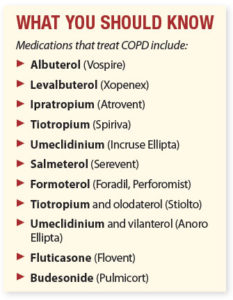Diagnosis and Treatment of COPD Is a Must to Preserve Lung Function
Chronic obstructive pulmonary disease (COPD) is a term for lung diseases that include emphysema and chronic bronchitis. Women are 37 percent more likely than men to have COPD, and it is the third leading cause of death in the U.S. Like many other chronic diseases, COPD is undiagnosed in many patients who have it—and, like many other diseases, getting diagnosed and treated if you have COPD can help stop the condition from progressing.
“Medication can improve lung function and quality of life in patients with COPD, so it’s important for women with COPD symptoms, such as shortness of breath or a chronic cough, to acknowledge and report them to their doctors,” advises Kirana Gudi, MD, assistant professor of medicine at Weill Cornell Medical College.
Reporting Symptoms Is Key
Many patients aren’t diagnosed with or treated for COPD because they don’t report symptoms to their doctors, so they are not screened for the disease. Common symptoms of COPD are dyspnea (shortness of breath), chronic cough, and sputum (mucous or phlegm) production. However, these symptoms are often overlooked or minimized.
“In the early stages of COPD, patients may only exhibit shortness of breath with exertion, such as when exercising or walking up stairs, and they may mistakenly attribute this to getting older or being ‘out of shape.’ When this is the case, patients frequently limit their activity to avoid these symptoms, and will therefore not report any shortness of breath when asked by their doctors. Additionally, some patients attribute their cough or phlegm to being simply a ‘smoker’s cough’ and not a pathological entity,” says Dr. Gudi.
The most significant risk factor for COPD is current or prior tobacco use. Often, patients who currently smoke are reluctant to report symptoms.
“Active smoking is a reason that people do not tell their doctors that they have symptoms of COPD,” notes Dr. Gudi. “Patients feel guilty talking about their symptoms with their doctors when they are actively smoking. This is unfortunate, because it prevents patients from being treated for their disease.”
COPD Can Be Dangerous
For some COPD patients, a chronic cough and becoming short of breath may be bothersome but  not a cause for serious concern. However, an exacerbation of symptoms can result in a feeling of choking or being unable to get enough oxygen, and it can be fatal, especially if medical treatment isn’t immediately available.
not a cause for serious concern. However, an exacerbation of symptoms can result in a feeling of choking or being unable to get enough oxygen, and it can be fatal, especially if medical treatment isn’t immediately available.
During an exacerbation, patients may experience increased shortness of breath and/or the inability to catch their breath. If they have a chronic cough, it may become more frequent and more severe. Patients also report hearing themselves make wheezing or whistling noises when they breathe.
For severe exacerbations, some patients require treatment with oxygen, and some require hospitalization.
Diagnosing COPD
The most common test for COPD is lung spirometry, a test that typically will show airflow obstruction if COPD is present. The test is not invasive and takes only a few minutes to complete.
“Any former or current smoker should be asked about symptoms of COPD and screened with spirometry if they have symptoms,” says Dr. Gudi.
COPD Medications
The goal of treatment for COPD is to control symptoms, improve patient function and quality of life, and decrease exacerbations of the disease.
“The ‘gold standard’ medications for all patients with COPD are inhaled bronchodilators,” says Dr. Gudi. “Bronchodilators work by opening up the airways. They have been shown to decrease exacerbation rates, improve lung function, reduce symptoms, and improve quality of life in patients with COPD.”
Bronchodilators may be short-acting or long-acting. Sometimes, bronchodilators are given in combination with inhaled glucocorticoids (medications containing steroids).
“These medications help decrease inflammation within the airways. However, inhaled steroids should not be the only treatment for patients with COPD,” cautions Dr. Gudi.
Other Helpful Measures
“For patients who currently smoke, smoking cessation is first and foremost—it decreases the rate of decline in lung function,” says Dr. Gudi. If you smoke, talk to your doctor about treatment options for smoking cessation and/or use free resources online, such as smokefree.gov, to help you quit.
Dr. Gudi notes that pulmonary rehabilitation programs, which include exercise, education, and support, can be critical in restoring exercise capacity, decreasing shortness of breath, and improving quality of life. Your doctor can refer you to a pulmonary rehab program if you have been diagnosed with COPD.
If you have COPD, it’s important to be vaccinated both for influenza and pneumococcus to prevent flu and pneumonia, which can be serious and even fatal in patients with underlying lung disease.
“Oxygen therapy can improve survival and quality of life in some patients with advanced COPD,” adds Dr. Gudi. “Finally, in some cases, there are surgical techniques, including lung resection and transplantation, that can be effective in select patients with COPD.”
The post Diagnosis and Treatment of COPD Is a Must to Preserve Lung Function appeared first on University Health News.
Read Original Article: Diagnosis and Treatment of COPD Is a Must to Preserve Lung Function »

